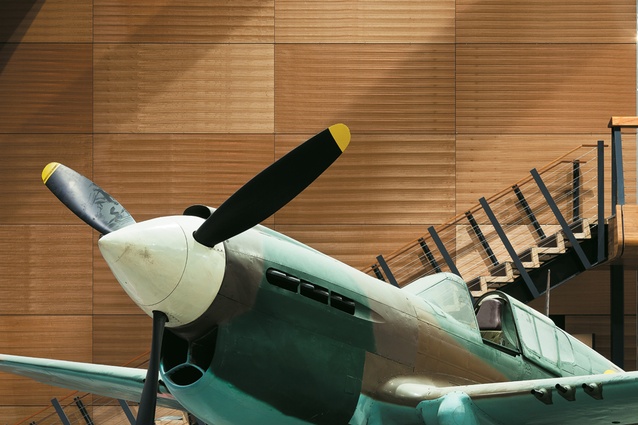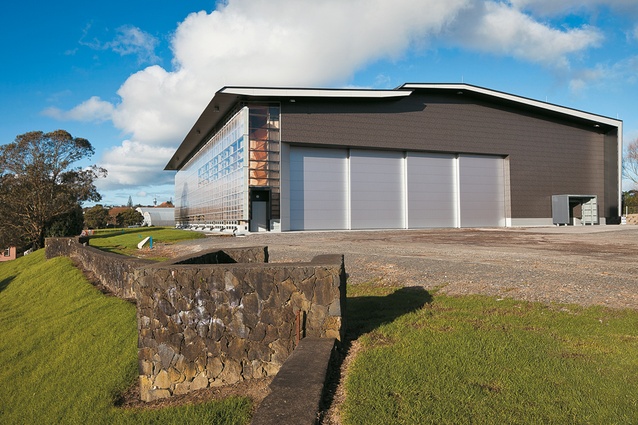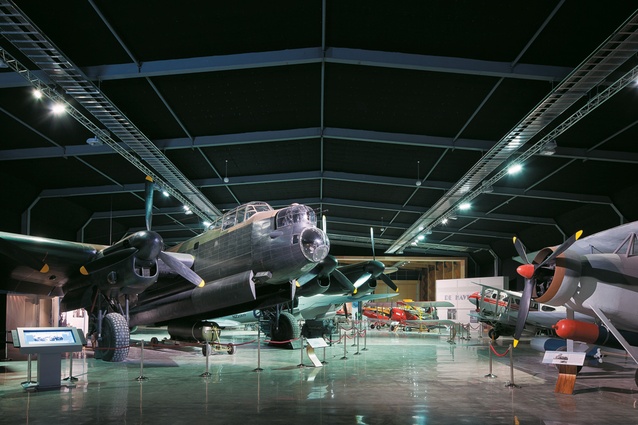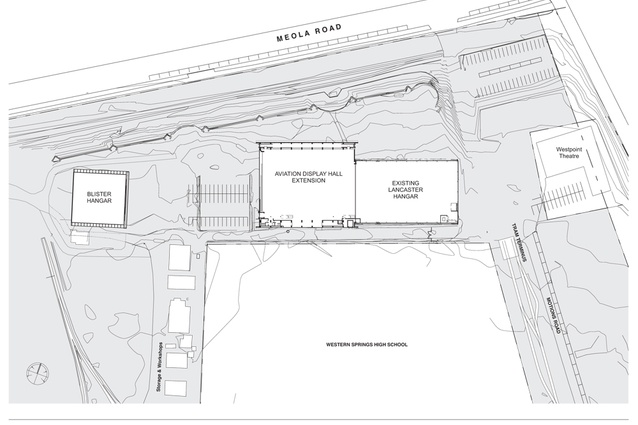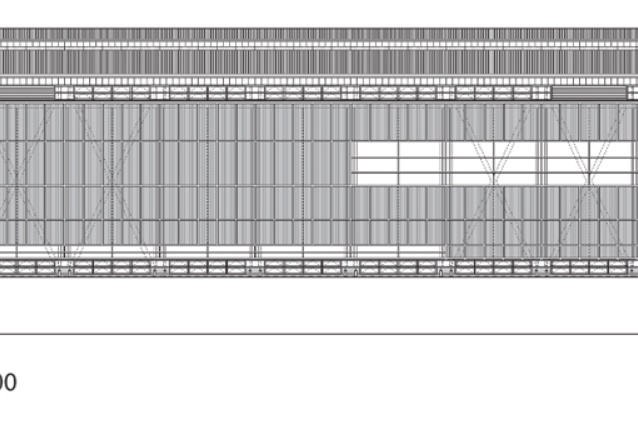MOTAT Aviation Display Hall
Studio Pacific’s hangar-like hall acknowledges the engineered-timber heritage of many of the machines housed within.
Times of shortage logically provoke a search to find either replacements or more economical ways of doing things. Times of crisis add a sense of urgency to this quest – or at least they should if logic is indeed a characteristic of the human condition. Sometimes it is, as was the situation in Britain during 1942 when, under the stress of war conditions and faced with a critical shortage of the metals needed for advance aircraft production, the Air Ministry approved plans for the mass-production of a high-performance fighter bomber made – of wood. The plane, the Mosquito, was beautiful in appearance and outstandingly successful in use.
Nicknamed ‘The Wooden Wonder’ its construction of spruce, balsa wood and other timbers in various thicknesses of plywood enabled the expertise of Britain’s furniture industry to be utilised for the war effort, freeing-up both scarce material and skilled metalworkers for other tasks. At the end of the war New Zealand purchased no fewer than 80 Mosquitoes and one of the survivors is now housed at MOTAT in Auckland’s Point Chevalier. It sits, sleek and elegant, in a new hangar designed by Studio Pacific Architecture.
Times change but situations recur. New Zealand is happily not now at war, although it is possible to argue that in fact we’re all of us collectively and most of us individually at war with the planet. But whether it’s war or merely careless exploitation, we are now starting to encounter the first signs of a scarcity of resources that, unless it can be addressed effectively, will impoverish future generations and may develop into a crisis which will threaten the survival of human societies on earth. Architects have a part to play in acting to mitigate the consequences of this situation.
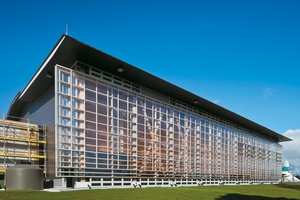
Studpac’s Aviation Display Hall is a large 2,850m2 shed, highly visible to the commuter traffic which flows along Meola Road and acting as a form of advertisement to the museum. It is directly attached to a pre-existing hangar forming a common internal space housing many of the historic aircraft in MOTAT’s collection. It is nevertheless a separate form from the more basic pre-existing building, and tends to provide a semblance of order to the series of large sheds which sit like beached whales along this otherwise park-like stretch of road.However, the analogy is not with marine mammals but with aircraft and this hangar acknowledges the engineered-timber heritage of many of the machines which it houses, the mighty ‘Mossie’ included. The structural system employed is a series of substantial radiata LVL box portals spanning just over 40 metres and supported on two separated legs at either end. It is the nature of this material, frequently exploited by architects, that the veneers are exposed on the edges making its nature clearly visible. The double legs of the portal frames emphasise this, as well as creating two slots of secondary spaces along the building edges: servant spaces to the served space of the hangar proper in which the aircraft are housed.
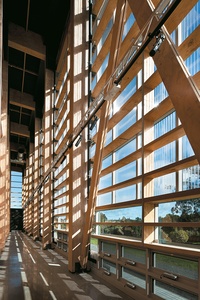
On the south side this aisle is occupied by a mezzanine viewing platform and a series of store rooms and toilets. On the north wall, however, a more interesting space is created with a translucent plexiglass skin to the outside and a perforated veneer face to the exhibition hall. This full-height volume acts as a ventilated heat-chimney within which a natural stack effect will provide air-movement for the building. The glazing to the public face of the building suggests that the exhibits might be visible from the road, but the aircraft are in fact entirely screened by the inner face of this northern aisle. Nevertheless, from the outside the glazing does provide a sense of openness and the whole structural system of the building, portal legs, girts, braces and all, is open to view. As a result it’s an eventful façade which catches the eye and operates successfully at the scale of the passing traffic.
There is a long history of architects being inspired by transport technology. In 1933 Adalberto Libera of the fabulous Casa Malaparte designed the Italian pavilion for the Chicago World Fair in the plan form of an aircraft, “a dynamic sign to represent fascism in the exhibition of ‘a century’s progress’” in the words of his chroniclers Garofalo and Veresani. Others, with perhaps different motivations, have looked to the water, inspired by the ways in which boats are made. St Benedict’s Chapel, which Peter Zumthor designed in the 1980s, has a roof with a skeletal timber structure reminiscent of the ribs of a ship. There are many other examples. Studio Pacific are less literal in their references, although they do refer to the roof as a ‘folded wing’, with the step which occurs in it just off-centre being likened to ailerons, which are small hinged sections on the outboard portion of a wing used to control the aircraft in roll.
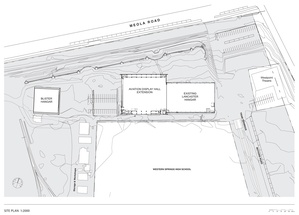
But it is as well not to try too hard: rather, hints can be dropped for observers to pick up or not as they choose. In fact, the important issue about this building is not that it is like an aeroplane, but that it responds to the conditions of its time: confronted with the need to design a large shed, the architects determined to do it in ways that were as economical of increasingly scarce resources as possible: to build with sustainable materials, to harvest rainwater, to naturally ventilate and as far as possible naturally heat the interiors. Environmental responsibilities have been taken seriously. The staff report that the building performs well, but physical and even operational reality is only part of what’s going on. Buildings have a social presence and this is certainly the case in a museum building which, with its educational purpose firmly in mind, may well act as an example of matters to do with building as well as a container for historic objects. To this extent the Aviation Display Hall has a social purpose. If the object of the Arts is that they contribute positively to the project for the betterment of mankind, as was the belief of the thinkers of the Enlightenment, then this building is a step in the right direction. It cannot deliver the Enlightenment project of human unity and perfectibility for that is alien to our time, as it is perhaps to all times. But this building can and does represent communal and civic ideals. Is it as beautiful as the Mosquito? No, and it’s not as fast either, but it is smart in at least two senses of the word for it works sensibly and looks good: a satisfactory enough judgement for an elegant shed.

